Catalogue: Scotland
![[James Hamilton.] Hamilton, Comte d'Aran.](img-thumbnail/jpegs/45007.jpg)
[James Hamilton.] Hamilton, Comte d'Aran.
Adr.n vander Werff pinx. P. à Gunst sculpt.
[Rotterdam, Reinier Leers, c.1707.]
Fine engraving, 18th century watermark. 360 x 235mm (14¼ x 9¼"), large margins.
Circular portrait of James Hamilton (c.?1537-1609), 3rd Earl of Arran. He was proposed as a suitable husband for both Mary Queen of Scots and Elizabeth I, but he had a mental breakdown aged thirty and was confined for the rest of his life, nearly fifty years. An illustration to Isaac de Larrey's 'L'Histoire de l'Angleterre'.
[Ref: 45007] £90.00
(£108.00 incl.VAT)
![[George Hamilton Gordon, 4th Earl of Aberdeen.]](img-thumbnail/jpegs/48495.jpg)
[George Hamilton Gordon, 4th Earl of Aberdeen.] Aberdeen [facsimile signature].
Painted by The late Sir Thomas Lawrence P.R.A. &c.&c. Engraved by Samuel Cousins A.R.A.
London: Published 26th Jan:y 1853, by Frederick Gwynne, Charing Cross.
Mezzotint on chine collé. 550 x 420mm (21¾ x 16½"), with very large margins.
The 4th Earl of Aberdeen (1784-1860), Prime three-quarter length, wearing dark suit with sash and star. The portrait was engraved by Cousins in 1831: it was reissued when Abderdeen became Prime Minister (1852-55). He was educated at St John's College, Cambridge, graduating with a Master of Arts in 1804.
[Ref: 48495] £280.00
(£336.00 incl.VAT)
![''Scalpa Island''. (Western Islands) [pencil].](img-thumbnail/jpegs/49247.jpg)
''Scalpa Island''. (Western Islands) [pencil]. Just Published. ''Scalpa Island'' (Western Islands) Original Drypoint by W. Renison. Edition limited to 105 impressions (Plate Destroyed).
W Renison [pencil signature.]
[n.d., c.1930.]
Etching, signed by the artist. 170 x 300mm (6¾ x 11¾"). In original mount with a printed title label of Alfred Bell & Co. Mint.
Trees on Scalpa, part of Harris in the Outer Hebrides. William Renison (1868-1939), Scottish painter who exhibited at the RA and in Paris. Guichard: p.55.
[Ref: 49247] £120.00
(£144.00 incl.VAT)
![[Sir Charles Hay] Lord Newton.](img-thumbnail/jpegs/54045.jpg)
[Sir Charles Hay] Lord Newton.
Painted by H. Raeburn Esqr. ARA. Engraved by Cha.s Turner.
Published March 1st 1814 by John Marnoch, Carver & Gilder, Princes Street, Edinburgh.
Mezzotint. 510 x 410mm (20 x 16¼"), with wide margins.
Half-length portrait of Scottish judge Sir Charles Hay (c.1740-1811), who took the title Lord Newton when he was raised to the Bench in 1806. Hay was a member of the Crochallan Fencibles, a convivial club that met at the Anchor Close, a public house off Edinburgh's Royal Mile. Robert Burns was also a member: in 1797 the poet send Hay a copy of ''On the Death of the late Lord President'', with the comment: ''These kind of subjects are much hackneyed; and besides, the wailings of the rhyming tribe over the ashes of the Great, are damnably suspicious and out of all character for sincerity. These ideas damp'd my Muse's fire; however I have done the best I could'. Raeburn's oil is held by the National Gallery of Scotland (NG 522) but on loan. Whitman: 403. Frankau: 78
[Ref: 54045] £280.00
(£336.00 incl.VAT)
![[John Hay, 1st Marquess and 2nd Earl of Tweeddale.]](img-thumbnail/jpegs/52577.jpg)
[John Hay, 1st Marquess and 2nd Earl of Tweeddale.]
[after Sir Godfrey Kneller.]
[n.d. c.1780.]
Etching with drypoint, proof before letters. Sheet 190 x 165mm (7½ x 6½). Trimmed within plate.
John Hay (1626-1697), Lord Chancellor of Scotland 1692-96. He started the English Civil War as a Royalist, but switched sides because of Charles I's treatment of the Covenanters. Thus he fought for Charles at Nottingham in 1642, then for Parliament at Marston Moor in 1644, before joining the Royalists at the Battle of Preston in 1648. In 1660 he was imprisoned for support of James Guthrie, the Presbyterian 'Protestor', but when Charles II was restored to the throne he was appointed Lord President of the Scottish Council in 1663 and an Extraordinary Lord of Session in 1664.
[Ref: 52577] £130.00
(£156.00 incl.VAT)

John Earle of Tweeddale, Lord Hay of Yester, Privy Councellour to King Charles ye Second in both Kingdomes, and One of the Commissioners of the Treasurie and Extraordinary Lords of the Session in the Kingdom of Scotland; Anno Dom: 1667. and of his Age 41.
G: Kneller pinx: I: Smith fec:
[n.d. c.1690.]
Mezzotint. 335 x 235mm (13¼ x 9¼"). Small margins.
John Hay, 1st Marquess of Tweeddale (1626-1697), Lord Chancellor of Scotland. During the English Civil War he repeatedly switched allegiance between the Royalist cause and the Parliamentarians. In 1660 he was imprisoned for support of James Guthrie, but when Charles II was restored to the throne, he was appointed Lord President of the Scottish Council in 1663 and an Extraordinary Lord of Session in 1664.
[Ref: 30885] £220.00
(£264.00 incl.VAT)

Vera Effigies Rev:mi Viri D:mi Alex: Hendersoni Scoto-Britanni. Yow that can find no object where to place / Your wonder, Come behold this gratious face. / Tis He the great Reformer of his dayes / That pow'rfull Light who spread the brighter rayes / Through Brittain half benighted, which did make / Truth to Triumph, proud Babells Whoor to quake.
W. Hollar fe 1641 [after Anthony van Dyke.]
Etching. Sheet 155 x 110mm (6 x 4¼"). Trimmed within plate, mounted in album paper
Alexander Henderson (c. 1583-1646), one finger used as a bookmark. He was a Scottish theologian mainly responsible for the final form of the 'National Covenant' of 1636 (which pledged to maintain the 'true reformed religion' against the policies of Charles I) and the 'Solemn League and Covenant' of 1643 (which, after slight alteration, became law in both Scotland and England). NPG D26867; see Scottish National Portrait Gallery PG 2227 for van Dyke's oil. Pennington: 1415.
[Ref: 42285] £120.00
(£144.00 incl.VAT)

Vera Effigies Rev:mi Viri D:mi Alex: Hendersoni Scoto-Britanni. Yow that can find no object where to place / Your wonder, Come behold this gratious face. / Tis He the great Reformer of his dayes / That pow'rfull Light who spread the brighter rayes / Through Brittain half benighted, which did make / Truth to Triumph, proud Babells Whoor to quake.
W. Hollar fe 1641 [after Anthony van Dyke.]
Etching. Sheet 165 x 110mm (6½ x 4¼"). Trimmed within plate, laid on album paper, numeral ''14'' written in print area.
Alexander Henderson (c. 1583-1646), one finger used as a bookmark. He was a Scottish theologian mainly responsible for the final form of the 'National Covenant' of 1636 (which pledged to maintain the 'true reformed religion' against the policies of Charles I) and the 'Solemn League and Covenant' of 1643 (which, after slight alteration, became law in both Scotland and England). NPG D26867; see Scottish National Portrait Gallery PG 2227 for van Dyke's oil. Pennington: 1415
[Ref: 42118] £95.00
(£114.00 incl.VAT)
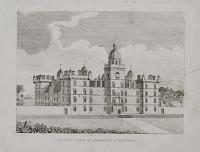
Front View of Heriot's Hospital.
[n.d. c.1815.]
Engraving with very large margins. Plate 165 x 215mm (6½ x 8½"). Repaired tear and creasing.
A view of the front of Heriot's Hospital, now George Heriot's school, which was established in 1628 by bequest of royal goldsmith George Heriot and opened in 1659.
[Ref: 30846] £95.00
(£114.00 incl.VAT)

The Highland Piper.
Frederick Taylor lithotint. C. Hullmandel's Patent.
[n.d., c.1845.]
Lithotint. Sheet: 365 x 540mm (14½ x 21¼") large margins.
A scene in a Scottish home in which a young boy dances the Highland fling while a man plays the bagpipes and children and dogs look on.
[Ref: 47742] £95.00
(£114.00 incl.VAT)

Scottish Soldiers of the Highlands. An Highland Officer and Serjeant. Engraved for Spencer's New History of England.
Published by Alex.r Hogg. Nov.r 30 1793
Engraving, sheet 230 x 370mm (9 x 14½"). Crease through centre.
Plate from George William Spencer's 'A New, Authentic, and Complete History of England', written with the assistance of Alexander Douglas and Hugh Fitzwilliam.
[Ref: 45256] £130.00
(£156.00 incl.VAT)
![The Highlander. This is the last and only Remains of the Roman Dress that at present exists in Europe. [&] A Highlander - Un Montagnard d'Ecosse.](img-thumbnail/jpegs/53657.jpg)
The Highlander. This is the last and only Remains of the Roman Dress that at present exists in Europe. [&] A Highlander - Un Montagnard d'Ecosse.
Pub'd according to Act of Parl.t Sep.r 12th 1771 by M.Darly at No. 39. Strand. [&] Pub'd according to Act of Parl.t by M.Darly Oct 2.d 1771.
Pair of engravings, each 210 x 160mm (8½ x 6½") Trimmed to plate. Some staining.
A highlander wearing kilt & plaid (ie. tartan cloth slung over the shoulders) from front and rear. At the time of publication the anti-Jacobite 1746 Dress Act banning tartans as common wear was still in force. It was repealled in 1782.
[Ref: 53657] £160.00
(£192.00 incl.VAT)

James Hogg.
[William Nicholson.]
[c.1820.]
Stipple, sheet 220 x 140mm. 8¾ x 5½". Sheet trimmed. Tear in top edge.
James Hogg (1770-1835), poet; 'The Ettrick Shepherd'. Hogg was born on a farm in Selkirkshire and worked as a shepherd. His employer lent him books and he began to write, publishing a slim volume of poems in 1801. In 1810, he moved to Edinburgh and in 1813 published his narrative poem ‘The Queen's Wake’, which tells of the return of Mary, Queen of Scots, to Scotland after her long stay in France. It was immediately recognised as a major achievement, and his reputation as a leading poet of his generation was established. Hogg published several more volumes of verse and a number of novels including The Three Perils of Woman (1823). Little regarded for many years, the second half of the twentieth century saw a revival in Hogg's reputation. After William Nicholson (1781 - 1844). NPG: D14893.
[Ref: 12972] £50.00
(£60.00 incl.VAT)
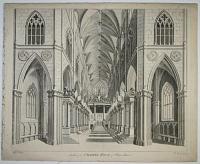
Inside of the Chappel Royal of Holyroodhouse.
Wyck Delint. P. Mazell Sculpt.
[n.d., c.1745.]
Etching, 415 x 485mm.
The Palace of Holyroodhouse, or informally Holyrood Palace, founded as a monastery by David I of Scotland in 1128, has served as the principal residence of the Kings and Queens of Scotland since the 15th century. The Palace stands in Edinburgh at the bottom of the Royal Mile. The Palace of Holyroodhouse is the official residence in Scotland of the Queen.
[Ref: 7719] £320.00
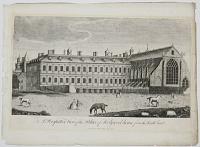
A Perspective View of the Palace of Holyrood house from the South East.
Pub. H. Paton 21 Horse Wynd College Edin.r. [n.d., c.1830.]
Engraving, with large margins. 205 x 330mm, 8 x 13". Edges frayed.
A reissue of the view after John Elphinstone, originally published c.1740, still showing the roof of the abbey church that collapsed in 1768 and never replaced.
[Ref: 26544] £85.00
(£102.00 incl.VAT)
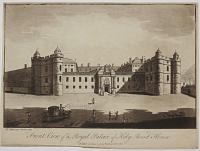
Front View of the Royal Palace of Holy Rood House.
Ph. Mercier delin 1781.
Publish'd according to Act of Parliament Dec.r 1782.
Aquatint and etching, a very rich aquatint; paper watermarked. 280 x 375mm (11 x 14¾"). Crease, cut.
A front view of Holyrood Palace with the 16th century north-west tower on the left; the rest of the palace dates fron the 17th century. Holyrood Abbey was founded in 118 by David, King of Scots, and in the early 16th century, James IV constructed a palace adjacent to the abbey. In the Hunteratina Museum and Art Gallery: GLAHA 9126.
[Ref: 30983] £240.00
(£288.00 incl.VAT)
![The Palace of Holyrood [in image.]](img-thumbnail/jpegs/27374.jpg)
The Palace of Holyrood [in image.]
J.D. Harding [signed on stone].
[London: E. Gambert and J. Hogarth, c.1850s.]
Hand-coloured lithograph with gum arabic, image 300 x 440mm. 11¾ x 17¼". Wide margins.
The Palace of Holyroodhouse in Edinburgh, the Queen's official residence in Scotland; as seen over rooftops, figures on high road in foreground. For John Parker Lawson's folio 'Scotland delineated in a series of Views...' (1847-1854, 2 vols), after various artists; the majority of plates were lithographed by James Duffield Harding (1798 - 1863). This print seems to be after Harding's own design. Abbey Scenery 493, 3.
[Ref: 27374] £95.00
(£114.00 incl.VAT)
![[Holyrood Palace, Scotland.] 72.](img-thumbnail/jpegs/25816.jpg)
[Holyrood Palace, Scotland.] 72. [Holyrood Palace is the chief royal palace in Scotland, and the residence of Mary, Queen of Scots, for the six tragic years. The buildings are in an unimposing French style forming a quadrangle, with the historical apartments on one side the state apartments on the other. The Palace was begun in 1500 by James IV. Since the departure of James VI (1603) to ascend the English throne, Holyrood has seldom been visited, and never occupied for any length of time, by any crowned head. Queen Victoria occassionally used the Palace, and George V. and Queen Mary were in residence for some days n 1927.]
Arthur Spencer [pencil signature to the bottom left-hand side outside the image]
[n.d. c.1920.] Copyright. F. & M. Ltd., Bedford, Eng.
Etching with accompanying letterpress text. 255 x 286mm. 10 x 11¼". Small crease to lower right corner
The Palace of Holyroodhouse, with a view of the ruined Augustinian abbey, founded in 1128 at the order of King David I of Scotland.
[Ref: 25816] £50.00
(£60.00 incl.VAT)
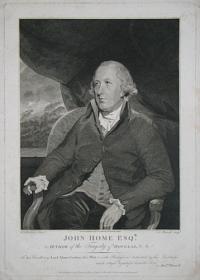
John Home Esqr. Author of the Tragedy of Douglas, &c.&c.
H. Raeburn Pinxt. A. Birrell Sculpt.
Pub: according to Act of Parliament, May 9th. 1799, by A: Birrell, No.53, Rosoman Street, Clerkenwell.
Engraving, 435 x 305mm. 17 x 12". A fine impression.
John Home (1722 - 1808), Scottish minister and dramatist. After Sir Henry Raeburn (1756 - 1823). NPG: D35939.
[Ref: 13196] £130.00
(£156.00 incl.VAT)
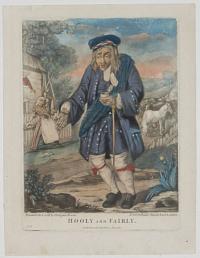
Hooly and Fairly.
Printed for & sold by Carington Bowles, No.69 St. Paul's Church Yard, London. Publishes as the Act directs, 4 June, 1787.
Rare hand coloured mezzotint. Platemark: 150 x 110mm (6 x 4¼").
An elderly Scottish man in a landscape, directed to left. He wears a tartan scarf over his left shoulder, and a round Scots bonnet, with his right arm extended in front of him. A cane is looped pver his left wrist, as he holds a cup and lid in his left hand. Behind, to the left is a cottage, outside which stands a woman smoking a clay pipe, raising a glass above her head as she leans against a fence. An empty bottle can be seen in front of her on the floor. On the right is a farm building with a horse and two cows outside. In the foreground to the right is a large thistle. Ex: collection of the late Hon. C. Lennox-Boyd.
[Ref: 33019] £120.00
(£144.00 incl.VAT)

Francis Horner Exqr M.P. Born 12August 1778, Died 8Feb 1817. From the Original Picture by Henry Raeburn Esqr. R.A. is the possession of Leonard Horner Esqr to whom this Print is respectfully dedicated by his obliged and obedient Servant. S. W. Reynolds.
Engraved & Published by S. W. Reynolds Bayswater, July 4, 1818
Mezzotint, with very large margins. Plate 407 x 299mm. 16 x 11¾". Repairs around platemark.
Francis Horner (1778-1817) was a Scottish Whig MP for St. Ives in 1806, Wendover in 1807, and St. Mawes in 1812. As a writer he translated Leonhard Euler's 'Elements of Algebra' in 1797 and published 'Short Account of a late Short Administration' in 1807. In 1802 he was one of the founders of the Edinburgh Review. Firms believed in political economy, he took part in the parliamentary debates on the Corn Laws and slavery in 1813-15. Ex Collection: Norman Blackburn. Whitman: 151.
[Ref: 19796] £190.00
(£228.00 incl.VAT)
![[Patrick Hume] Patricius Comes de Marchmont, Vicecomes de Blasonberrie, Dominus Polwarth de Palwarth,](img-thumbnail/jpegs/41332.jpg)
[Patrick Hume] Patricius Comes de Marchmont, Vicecomes de Blasonberrie, Dominus Polwarth de Palwarth, Redbreas et Greenlaw... Ano Dni 1698.
G. Kneller Eques pinxit. R. White sculpsit.
[c.1698.]
Rare engraving. 465 x 345mm (18¼ x 13½"), large margins.
A portrait of Patrick Hume (1641-1724), 1st Earl of Marchmont. He was Lord Chancellor of Scotland 1696-1702 and voted for the union of Scotland with England in 1706.
[Ref: 41332] £320.00

Inchoch Castle.
[illegible] 1813.
Soft-ground etching, rare with very large margins, platemark 215 x 250mm (8½ x 9¾"). 'Miss Erskine' in ms lower margin.
Amateur etching of Inshoch Castle, near Inverness, Scotland. Ex: Collection of the Late Hon. C. Lennox-Boyd.
[Ref: 33774] £180.00
(£216.00 incl.VAT)

Inverary Castle, Argylshire.
Drawn & Engraved by Will.m Daniell.
Published by Messrs. Longman & Co., Paternoster Row & W. Daniell, 9 Cleveland Street, Fitzroy Square, London, May 1, 1817.
Aquatint with fine original hand colour. 230 x 300mm (9 x 12"). Watermarked 'J. Whatman 1816'. Large margins, uncut.
A view of Inverary, seat of the Dukes of Argll, from across Loch Fyne. From William Daniell's 'A Voyage Round Great Britain', a series of 308 aquatints published in eight volumes between 1814-1825, described by R.V. Tooley as 'the most important colour plate book on British Topography'. Abbey: Scenery, 16; Tooley: Books with Coloured Plates 177.
[Ref: 36278] £160.00
(£192.00 incl.VAT)

The Town of Inverness.
Drawn on the Spot by I. Clark.
London, Published by Smith & Elder, Fenchurch Street, 1823 (but later).
Hand-coloured etching and aquatint. Plate 475 x 629mm (18¾ x 24¾"). Slightly trimmed, slight paper toning.
Inverness, in the Scottish Highlands, where the River Ness enters the Moray Firth, from the "Views in Scotland" series. Although it cannot be proved it is believed that 'I. Clark" is the Scottish painter John Heaviside Clark, famed as 'Waterloo Clark' for his early sketches of the Battle. He was also skilled in aquatinting, and certainly none of this series has a named engraver. Abbey Scenery:489.32. GAC: 3933. RMG: PAH9852.
[Ref: 28777] £320.00
![Iona Cathedral_West Front. [&] Iona Cathedral_East Front.](img-thumbnail/jpegs/27786.jpg)
Iona Cathedral_West Front. [&] Iona Cathedral_East Front.
Drawn & Lithographed by Allan & Ferguson, Glasgow.
[n.d. c.1840.]
Tinted lithograph pair printed on same sheet. Sheet 357 x 255mm. 14 x 10". Slightly trimmed.
Iona Abbey, located on the Isle of Iona, off the West Coast of Scotland. The abbey was a focal point for the spread of Christianity throughout Scotland and marks the foundation of a monastic community by St. Columba, when Iona was part of the Kingdom of Dal Riata.
[Ref: 27786] £120.00
(£144.00 incl.VAT)

The Rev.d E. Irving. Of the Caledonian Church, Cross Street, Hatton Garden.
Drawn from Life by G.H. Jones.
London. Pub.d by Thomas Mc.Lean, 26 Haymarket Aug.t 16, 1823.
Lithograph on india. 235 x 165mm (9 x 6½") large margins.
Rev. Edward Irving (1792-1834) was a Scottish clergyman, generally regarded as the main figure behind the foundation of the Catholic Apostolic Church. He had little success in converting the Scottish public and was about to give up hope and focus his attention towards missionary labour in the East when he suddenly received an invitation from the Caledonian Church in London; over that charge he was ordained in 1822.
[Ref: 53564] £130.00
(£156.00 incl.VAT)
!['Isle of Arran' (Glen Sannox). [in pencil]](img-thumbnail/jpegs/62618.jpg)
'Isle of Arran' (Glen Sannox). [in pencil]
J Alphege Brewer [in pencil].
[n.d., c.1930.]
Coloured etching signed by the artist, 135 x 210mm (5½ x 8¼"), with very large margins.
A wonderful view of the hills of Glen Sannox, North Ayrshire in Scotland. James Alphege Brewer (1881-1946) was a well-known early 20th century producer of colour etchings - notably of English and European Cathedrals and churches and other scenes.
[Ref: 62618] £60.00
(£72.00 incl.VAT)

Jacobus Dei Gratia, Scotor etc. Rex. Engraved from a Scarce Print in the Possession of George Chalmers Esq.r.
Adam sculp.
London: Published 1 Jan.y 1798 by Robert Wilkinson, No 58 Cornhill.
Engraving. Sheet 230 x 160mm (9 x 6¼"). Trimmed within plate.
Full-length portrait of James I, King of Scots (1394-1437).
[Ref: 32701] £45.00
(£54.00 incl.VAT)
![[James II.]](img-thumbnail/jpegs/48637.jpg)
[James II.] Iacobus Dei Gratia. Scotor etc. Rex.
[n.d., c.1600.]
Engraving. Sheet: 200 x 140mm (8 x 5½''). Trimmed, repaired damage.
A portrait of James II of Scotland (1430-1460) from Ehingen's 'Itinerarium' 1600, shown standing next to a stag which holds the Stuart coat of arms. James died during the Siege of Roxburgh Castle, one of the last Scottish castles still held by the English after the Wars of Independence, when one of cannon he had imported from Flanders, known as "the Lion", exploded and killed him.
[Ref: 48637] £160.00
(£192.00 incl.VAT)

James 2: King of Scotes Ano 1436.
[by Richard Gaywood.]
[n.d., c.1655. ]
Etching with watermark. 150 x 100mm (6 x 4"). Slighting toning of paper.
James Stewart (1430-60), who became the second King James of Scots in 1437 after the assassination of his father, James I. He is credited with bringing the first artillery pieces to Scotland, including 'Mons Meg', now in Edinburgh Castle; he was killed when a cannon he was attempting to fire exploded. He is the earliest Scots monarch for whom a contemporary likeness has survived, in the form of a woodcut showing his birthmark on the face.
[Ref: 32705] £95.00
(£114.00 incl.VAT)

Jacobus III Rex Scotorum.
[n.d., c.1650. ]
Engraving, 17th century watermark. 165 x 130mm (6½ x 5¼"). Trimmed within plate on three sides.
James Stewart (1451-1488), who became the third King James of Scots in 1460 after his father, James II, was killed when trying to fire a cannon. An unpopular monarch, he died at the Battle of Sauchieburn, fighting disaffected nobles.
[Ref: 32706] £70.00
(£84.00 incl.VAT)

Jacques IV.
Adr.n vander Werff pinx. G. Valck sculpt.
[Rotterdam, Reinier Leers, c.1707.]
Fine engraving. 360 x 235mm (14¼ x 9¼"), large margins.
Bust portrait of James Stewart (1473-1513), the last British monarch to die on the battlefield, at Flodden, Northumberland. An illustration to Isaac de Larrey's 'L'Histoire de l'Angleterre'.
[Ref: 45002] £70.00
(£84.00 incl.VAT)

Jacques V.
Adr.n vander Werff pinx. P. à Gunst sculpt.
[Rotterdam, Reinier Leers, c.1707.]
Fine engraving. 360 x 235mm (14¼ x 9¼"), large margins.
Bust portrait of James Stewart (1512-42), father of Mary, Queen of Scots. An illustration to Isaac de Larrey's 'L'Histoire de l'Angleterre'.
[Ref: 45003] £70.00
(£84.00 incl.VAT)

Jacobus V Rex Scotorum.
[n.d., c.1650. ]
Engraving. 165 x 130mm (6½ x 5¼"). Trimmed within plate on three sides. Slight crease.
James Stewart (1451-1488), who became the fifth consecutive King James of Scots in 1460 after his father, James IV, was killed at Flodden Field in 1513. He died of an illness shortly after the Battle of Solway Moss: his six-day-old daughter Mary became Queen of Scots.
[Ref: 32708] £70.00
(£84.00 incl.VAT)

Georgius Iameson, Scotus Abredonensis, Patriae suae apelles, eiusque uxor, Isabella Tosh, et Filius.
Geo: Jameson. Pinxit Anno, 1623. Alex.r pronepos, fecit Aqua forte A:D: 1728.
A fine engraving. Plate 210 x 158mm. 8¼ x 6¼".
Portrait of the artist George Jamesone, with his wife and child; half length, his wife standing in centre holding roses, wearing a veil; George behind to the left, holding a palette and brushes over her left shoulder; their child to the right holding a flower. George Jamesone (1586-1644) the Scotch portrait painter, born in Aberdeen. He studied under Rubens, and was a fellow pupil of Van Dyck, in Antwerp.
[Ref: 23262] £130.00
(£156.00 incl.VAT)

William Jamieson, late Bellman, (and well known as the Caleb Quotem,) Of Largs, who perished in the snow, 3d. Feb. 1823.
D. Allen lithog. Glasgow.
[n.d., c.1825.]
Lithograph, sheet 278 x 222mm.
A local character of Largs, a town on the Firth of Clyde in Ayrshire, Scotland, with a view of the church behind. Very scarce, published in Glasgow.
[Ref: 8048] £140.00
(£168.00 incl.VAT)
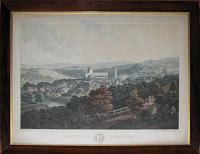
The Town of Jedburgh.
Drawn on the Spot by I. Clark.
London, Published by Smith, Elder & Co. 65 Cornhill, 1825.
Coloured aquatint, 510 x 665mm. 20 x 26¼". Framed in fine rosewood frame. Vertical crease at centre, some paper toning.
Jedburgh in the Scottish Borders, from the "Views in Scotland" series. On the centre are the ruins of Jedburgh Abbey, founded by the Augustines in 1138; above the town on the right is Jedburgh Castle Jail, built in the early 19th century on the site of the medieval castle Although it cannot be proved it is believed that 'I. Clark" is the Scottish painter John Heaviside Clark, famed as 'Waterloo Clark' for his early sketches of the Battle. He was also skilled in aquatinting, and certainly none of this series has a named engraver. Abbey No: 489.
[Ref: 12697] £490.00

Jedburgh.
Henry Martin sculp.t, 4 Swinton Street, London.
[London: House of Commons, 1832.]
Coloured engraving. 305 x 255mm, 12 x 9¾". Laid on and edged with linen. Some wear and surface dirt.
Jedburgh, a former royal burgh in Roxburghshire, Scotland, on a scale is 6 inches to a mile. Originally published at the time of the Reform Act (which adjusted the boundaries of parliamentary constituencies to take account of the urban drift caused by the Industrial Revolution), this map has been updated with manuscript to determine the extent of free delivery for mail, part of the Great Post Office Reform of 1839-40, championed by Rowland Hill. Another part of this reorganisation was the introduction of the Penny Black, the world's first postage stamp.
[Ref: 10181] £130.00

Jedburgh Abbey. This View is by Permission most humbly dedicated to J. Rutherford Esq.r of Egerston, by his obliged & obedient Servant, Will.m Wilson.
Drawn by W. Wilson. Engraved by F.C. Lewis.
London Published as the Act directs, Jan. 1. 1813, by W. Wilson, 53, Paddington Street, Baker Street.
Coloured aquatint, printed in blue and brown and hand finished. Sheet 505 x 630mm (19¾ x 24¾"), paper watermarked 'J Whatman 1817'. Trimmed within plate, notches in edges.
A view of the abbey from the side of Jed Water at Abbey Bridge.
[Ref: 59360] £320.00
![[John Knox's Home. Edinburgh.] 71.](img-thumbnail/jpegs/14643.jpg)
[John Knox's Home. Edinburgh.] 71. [John Knox's house is an interesting old house projecting into the High Street of Edinburgh. Knox's 'manse' is known to have been further up the street, but it is believed that he lived here for some time, towards the end of his life. Over part of the front of the ground floor is an inscription "Lufe God abufe al, and thi nychtbour as thi-self." The house, which stands near the old lower gate of the City, was purchased by the Free Church. The interior is well preserved and many relics of Knox are stored there. Perhaps the most interesting is the study where the great reformer is traditionally believed to have worked until a fortnight before his death.]
Arthur Spencer [pencil signature to the bottom left-hand side outside the image]
[n.d. c.1920.] Copyright. F. & M. Ltd., Bedford, Eng.
Etching. 256 x 285mm. 10 x 11¼".
John Knox (c.1510-1572) was Scottish clergyman and leader of the Protestant Reformation, and considered to be the founder of the Presbyterian denomination. Educated at the University of St Andrews and influenced by reformers such as George Wishart, he joined the movement to reform the Scottish church.
[Ref: 14643] £35.00
(£42.00 incl.VAT)

Keiss Castle, Caithness.
Drawn & Engraved by Will.m Daniell.
Published by W. Daniell, Cleveland Street, Fitzroy Square, London, June 1, 1821.
Coloured aquatint. Watermarked: J Whatman Turkey Mill 1820. Plate 228 x 303mm. 9 x 12". Uncut.
Keiss is a fishing village, Caithness, Scotland. The castle stands on sheer cliffs overlooking the bay. From William Daniell's Fifth Volume of "Voyage around Great Britain". Abbey: Scenery, 16; Tooley: Books with Coloured Plates 177.
[Ref: 20205] £140.00
(£168.00 incl.VAT)
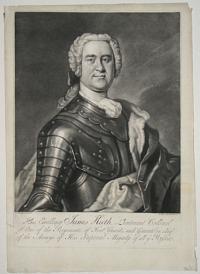
His Excellency James Kieth, Lieutenant Collonel of One of the Regiments of Foot-Guards, and General in Chief of the Armys of His Imperial Majesty of all the Russias.
A. Ramsay pinxit. A.Van Haecken fecit.
[n.d., c.1740.]
Mezzotint, 355 x 250mm. 14 x 9¾". Very scarce.
James Francis Edward Keith (1696 - 1758), Scottish field marshal of Prussia. Keith participated in the Jacobite uprising of 1715 and in the abortive invasion of 1719 with his brother; escaping to the Continent, he first entered the service of Spain and then went to Russia, where he gained honour in both civil and military offices, and was given command of a regiment of guards in 1728. Later he went to Prussia and became close friends with Frederick the Great, who made him a field marshal in 1747. Keith entered the circle of Europe’s leading intellectuals and rendered great service to Prussia in the early part of the Seven Years War, and was killed in the battle of Hochkirch. After Scottish portrait painter Allan Ramsay (1713 - 1784). See Chaloner Smith: 10. This version, without oval fame and pedestal, undescribed.
[Ref: 12199] £350.00

Kelso.
H. McCulloch R.S.A. W. Forrest
Published by Fraser & Co. 97 George St. Edin.r [n.d., 1849].
Scarce steel engraving. 425 x 570mm (16¾ x 22½"), with very large margins Margins toned and creased.
A view of Kelso from across the Tweed, with the bridge built by John Rennie, the ruins of Kelso Abbey and, in the left background, Floors Castle. It was painted by the celebrated scottish artist Horatio McCulloch, RSA (1805-1867).
[Ref: 56687] £460.00

View of the New Bridge over the River Tweed at Kelso, Scotland. Inscribed to John Rennie Esq.r Civil Engineer & F.R. A.S.S. &c. &c. by his obliged and obedient servant, William Daniell.
Painted, Engraved & Published by W.m Daniell No 9 Cleveland Street, Fitzroy Square, London, July 25 1804.
Fine coloured aquatint. Sheet 460 x 665mm (18 x 26½"). Trimmed within plate on three sides, laid on archival paper.
In 1797 the old bridge over the Tweed was washed away by floods, and the Scottish engineer John Rennie (1761-1821) was called in to build this bridge. He used the new technique of combining cast iron with stone to create wide arches previously unheard of in bridge construction. The Kelso Bridge was so impressive that he won contracts to build three major London bridges, Waterloo (a larger version of this bridge), Southwark & London Bridge (completed from his design after his death). In 1854 the Kelso population had to be read the Riot Act when they protested against the bridge tolls, fifty years after completion, and long after the construction had been paid for. Three years later the tolls were abolished. This plate attests to the skill of Daniell as an aquatinter: whereas most aquatints have lines added by engraving or etching, this image is pure aquatint, even the boatman's pole and the black border.
[Ref: 56952] £490.00

Kenmore on Loch Tay. from the Dairy.
Day & Haghe Lith.rs to the King, Gate St.t
[n.d. c.1840.]
Lithograph, rare. 171 x 222mm (6¾ x 8¾").
A view of Loch Tay, Perthshire, Scotland. Kenmore sits at the outflow of the River Tay.
[Ref: 30848] £65.00
(£78.00 incl.VAT)
![[Maxwell's Temple, Kenmore, Scotland] Cross Erected near Kenmore, and dedicated to the Marchioness of Breadalbane. 1830.](img-thumbnail/jpegs/27915.jpg)
[Maxwell's Temple, Kenmore, Scotland] Cross Erected near Kenmore, and dedicated to the Marchioness of Breadalbane. 1830.
[Anon., British, n.d., c.1830.]
Lithograph, rare; sheet 260 x 190mm. 10¼ x 7½".
This ‘Eleanor Cross’ was erected by Lord Breadalbane in 1831 as a tribute to his wife Mary, Countess of Breadalbane. Built on the site of an old summer house known as Maxwell's House on the north bank of the River Tay in Perthshire, Scotland, it stands 30 feet high and has a 9 step octagonal bottom that encircles the building, a cruciform middle stage and a square pinnacle top stage surmounted by cross.
[Ref: 27915] £120.00
(£144.00 incl.VAT)
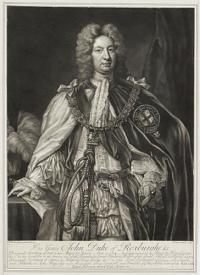
His Grace John Duke of Roxburghe &c. Principall Secretary of State to her Majesty Queen Anne in 1704...
J. Richardson pinx.t 1723. J. Faber fecit 1741.
Mezzotint. Sheet: 350 x 250mm (13¾ x 9¾"). Trimmed.
A full length portrait of John Ker, 1st Duke of Roxburgh (1680-1741), who served as Secretary of State for Scotland and helped bring about the union with England.
[Ref: 43048] £180.00
(£216.00 incl.VAT)

His Grace John Duke of Roxburghe &c. Principall Secretary of State to her Majesty Queen Ann in 1704 [...]
J. Richardson pinxt 1723. J. Faber fecit 1741.
Mezzotint with very large margins, fine; platemark 355 x 260mm (14 x 10¼").
John Ker, first duke of Roxburghe (c.1680-1741), politician prominent in Scottish politics from 1702 onwards. Roxburghe (as he was created in 1707) was part of the Scottish administration, known as the 'squadrone' which supported the Scottish government in the votes that led to the Union of 1707. He continued to play a role in the politics of the newly created British state, but backed John Carteret rather than the rising star, Sir Robert Walpole. Walpole dimissed Roxburghe from his office of (Scottish) secretary of state in 1725. Thereafter he lived largely in political retirement, and died in 1741 at Floors Castle, which had been built for him by Vanbrugh. Engraved after the 1723 portrait by Jonathan Richardson the elder, which hangs at Floors Castle. CS 309 (only state).
[Ref: 34513] £260.00
(£312.00 incl.VAT)
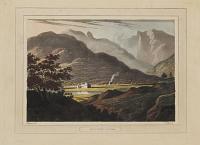
Kilchurn Castle.
Williams del. Merigot sc.
[n.d. c.1801.]
Hand-coloured aquatint and etching. 171 x 241mm (6¾ x 9½"). Fine.
Plate 15: a moorland with a tree on the left in the foreground, a ruined castle in a field across a river, smoke rising from one of the houses on the horizon, high mountains in the background. Kilchurn Castle, the ruined 15th century castle on the rocky penincsula in Loch Awe. From a series of "Picturesque Views of Scotland", published by John Stoddard c.1801. Abbey Scenery: 484.15.
[Ref: 31029] £70.00
(£84.00 incl.VAT)
![[James Hamilton.] Hamilton, Comte d'Aran.](img-thumbnail/jpegs/45007.jpg)
![[George Hamilton Gordon, 4th Earl of Aberdeen.]](img-thumbnail/jpegs/48495.jpg)
![''Scalpa Island''. (Western Islands) [pencil].](img-thumbnail/jpegs/49247.jpg)
![[Sir Charles Hay] Lord Newton.](img-thumbnail/jpegs/54045.jpg)
![[John Hay, 1st Marquess and 2nd Earl of Tweeddale.]](img-thumbnail/jpegs/52577.jpg)






![The Highlander. This is the last and only Remains of the Roman Dress that at present exists in Europe. [&] A Highlander - Un Montagnard d'Ecosse.](img-thumbnail/jpegs/53657.jpg)




![The Palace of Holyrood [in image.]](img-thumbnail/jpegs/27374.jpg)
![[Holyrood Palace, Scotland.] 72.](img-thumbnail/jpegs/25816.jpg)



![[Patrick Hume] Patricius Comes de Marchmont, Vicecomes de Blasonberrie, Dominus Polwarth de Palwarth,](img-thumbnail/jpegs/41332.jpg)



![Iona Cathedral_West Front. [&] Iona Cathedral_East Front.](img-thumbnail/jpegs/27786.jpg)

!['Isle of Arran' (Glen Sannox). [in pencil]](img-thumbnail/jpegs/62618.jpg)

![[James II.]](img-thumbnail/jpegs/48637.jpg)










![[John Knox's Home. Edinburgh.] 71.](img-thumbnail/jpegs/14643.jpg)





![[Maxwell's Temple, Kenmore, Scotland] Cross Erected near Kenmore, and dedicated to the Marchioness of Breadalbane. 1830.](img-thumbnail/jpegs/27915.jpg)


